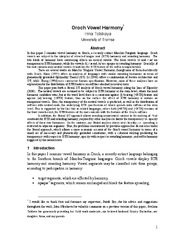| dc.description.abstract | In this paper I examine vowel harmony in Oroch, a recently extinct Manchu-Tungusic language. Oroch vowels are subject to the interplay of retracted tongue root (RTR) harmony and rounding harmony. The two kinds of harmony have contrasting effects on neutral vowels. The front vowels /i/ and / æ/ are transparent to RTR harmony, while the vowels /i/, /æ/, /ʊ/ and /u/ are opaque to rounding harmony. Crucially, if the root contains only neutral vowels /i/ and /æ/, the RTR feature of the suffix is unpredictable.
There are several works on Manchu-Tungusic Vowel Harmony, though none of them deal directly with Oroch. Kaun (1995) offers an analysis of languages with similar rounding harmonies in terms of phonetically grounded Optimality Theory (OT). Li (1996) offers a combination of feature architecture and
OT, while Zhang (1996) uses contrastive feature specification. However, none of these analyses have an explanation for the distribution of RTR features on suffixes attached to neutral roots.
This paper puts forth a Stratal OT analysis of Oroch vowel harmony, along the lines of Kiparsky (2000). The neutral vowels are assumed to be subject to RTR harmony at the stem level, where the most harmonic candidate wins, but at the word level there is a constraint against [i] bearing [+RTR] feature and against [æ] bearing [−RTR] feature; thus on the surface the effect of RTR harmony is undone on transparent vowels. Thus, the transparency of the neutral vowels is predicted, as well as the distribution of
suffixes with neutral roots, the underlying RTR specification of which spreads onto suffixes at the stem level. This is supported by the fact that in related languages, where both [+RTR] and [−RTR] versions of the front vowels exist, the RTR features of the root coincide with the features of the Oroch suffixes.
In addition, the Stratal OT approach allows avoiding unmotivated contrast in the ranking of *GAP constraint for RTR and rounding harmony, required by other analyses to derive the transparency vs. opacity effects of these two harmonies. On the contrary, my Stratal analysis obeys strict locality, i.e. preading is restricted to adjacent segments. Thus, the problems encountered by previous approaches do not arise under the Stratal approach, which allows a more economic account of the Oroch vowel harmony in terms of a
small set of necessary and phonetically grounded constraints, with a coherent ranking predicting the transparency with respect to RTR harmony, opacity with respect to rounding harmony, and suffix harmony triggered by the neutral roots. | en |


 English
English norsk
norsk